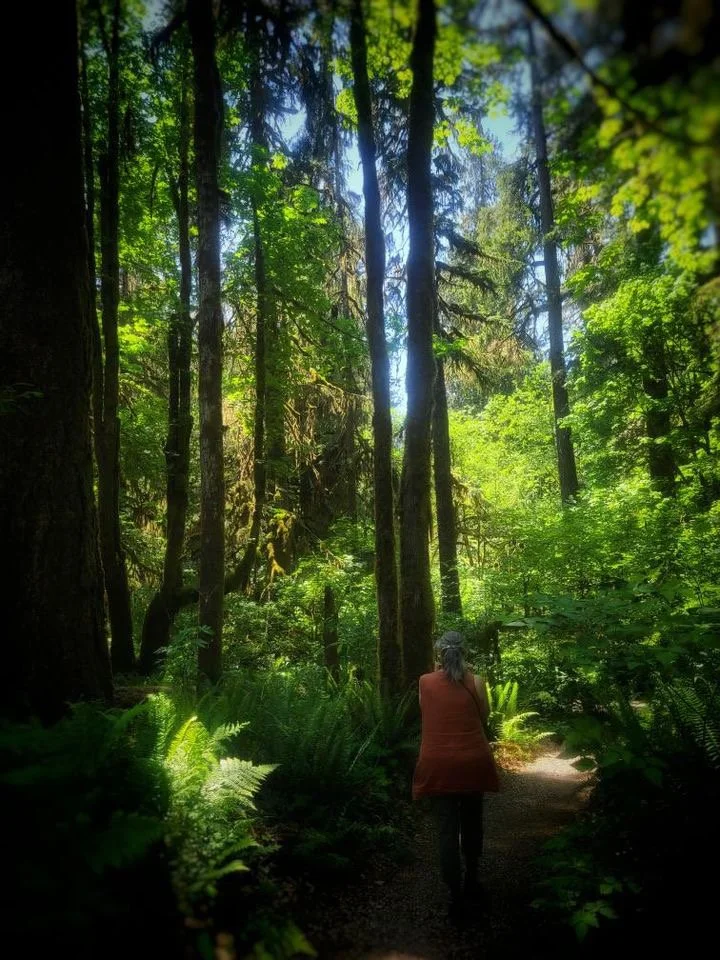Usnea- The Old Man's Beard of Winter
/I notice the Old Man’s Beard more in the winter.
The Old Man’s Beard is always present but takes pause and allows the surrounding plants to shine in the spring and fall, quietly hanging out (literally) in the back drop of the seasonal foliage. Old Man’s Beard is not actually a plant, but a lichen. A lichen is part algae and part fungus. It dehydrates with the summer season and becomes a lighter green and a bit scratchier self which is its subtle way of saying “I think I will hang here quietly and not get your attention. It is not the time of year (for harvest.)”
Now, in the quiet of the year with wind gusts off the river and powerful downpours that replenish the Earth also rehydrate the lichen, deepening its verdant green-grey color as it falls in my path. On still days, Old Man’s Beard hangs low on the limbs, inviting me to wrap it around my head as a crown or laugh while making mock beards mimicking the faeries who surely are in the woodlands as well.
A harvest of this potent medicine is easy after a strong wind or heavy rain- it falls lightly and with little damage to its quality. Just follow the weather.
Usnea barbata and Usnea longissima are the botanical names for the more prevalent lichen of the temperate rainforest here in the PNW. Common names are Old Man’s Beard, bears beard, moose moss, woman’s long hair and witches broom. I am especially fond of the common name meaning “spirit of the north wind” - chan wiziye (Lakota.)
In herbal medicine, Old Man’s Beard is typically called by its botanical name, Usnea. It is an indicator of clean air so if you live in an area where usnea is abundant- you are living in a vital woodland, breathe deeply and know you are blessed!
As a lichen, usnea is made up of algae and a fungus growing symbiotically on the solid surface of a tree. Here in the PNW, you will see usnea on the branches of alders and Douglas firs and at times, an entire forest will be covered, no matter what the tree. It is found throughout the world and especially likes open, well lit edges of woods where it attaches to spruces, firs, cottonwoods, manzanitas, oaks, and pines. It’s common name Old Man’s Beard reflects the visual of the hair like fibrils that attach to limbs in tufts of the U. longissimus with strands that hang from the trees up to 3 meters long or more.
As a herbal medicine, usnea has been studied for its use as an antibiotic and its effective treatment as an anti-microbial as well as its anti proliferation action, keeping infections from re-occurring. The compound most studied is Usnic acid; the bitter constituent found in the outer grey green cortex. This acid has proven effective against a number of human and plant pathogens, including multi-drug resistant strains of gram positive bacteria like Streptococcus and staph. Wow! That’s big news!
Usnea is cooling and opening to the lungs transforming phlegm- especially yellow or green phlegm that is frequently seen in lung infections. I would not go so far as say treating pneumonia is appropriate with usnea- but I have seen it resolve damp heat, especially in the lungs and bladder. Immune stimulating polysaccharides also prove helpful here and are found in the white inner core. Urinary tract, cystitis, urethritis, sinusitis, bronchitis and strep throat all call for this amazing lichen, humbly hanging from the trees in our backyards.
Topically, the herb can be powdered and applied to wounds, infective skin lesions or made into a salve to reduce the frequency of skin infections such as cellulitis. Usnea has anti-bacterial actions and is typically a rapid reducer when applied frequently using a quality preparation. Other topical applications include treatment of athlete’s foot, beard rot, cradle cap and ringworm.
Usnea is typically best made in to a tincture and some medicine makers will use a heated decoction/tincuring process for best results. I have seen both applications show improvement with my preference being the heated processing.
Finding Usnea in the woods is a simple task in my region but there are some lookalikes. To be 100 percent certain of your identification- use this simple test to clarify it’s the real deal. Usnea has an elastic like band in its inner surface. Take a length of unseal and slowly stretch the lichen apart- with even a gentle pull in the winter -it will pull apart and should display a tiny white band that flexes when pulled. There you go- you have found Usnea!
Dosage of tincture is 30-90 drops, up to 5 times a day during acute infection. Usnea is not recommended for long time daily use unless you are working with a clinical herbalist or doctor recommendation.
References:
Medicine at Your Feet, David Bruce Leonard
Essential Guide to Western Botanical Medicine, Christa Sinadinos
Personal experience with Usnea in its natural habitat.


